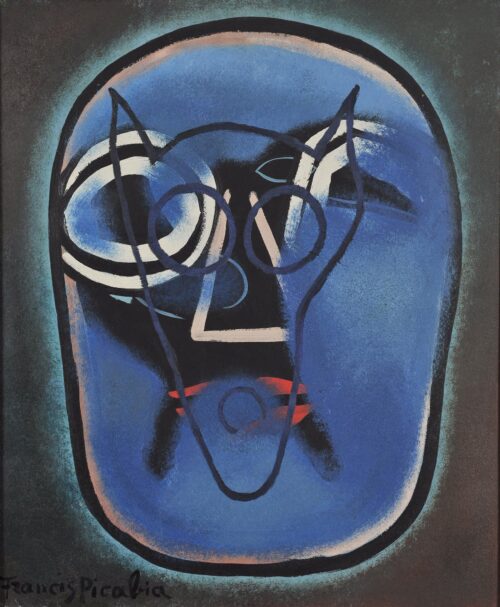
Picabia Francis (1879 - 1953)
Head, before 1949
From 1895 till 1897 he attended classes a the Ecole des Arts Decoratifs. He exhibited for the first time at the Salon de la Societe des Artistes Francais in 1899. His early works were impressionistic in style and were favorably received by the art market. In 1905 and 1907 he held his first two solo exhibitions. In 1908 he met and married the musicologist Gabrielle Buffet who made a decisive contribution to his development. Their views concerning art were completely in tune with the most avant garde ideas of the era. As a natural consequence, Picabia abandoned his Pointillism and Impressionism and was then influenced by Fauvism and, later, Cubism. In 1911 he met Apollinaire and Marcel Duchamp. Orphism led to Cubist compositions and in 1912 he exhibited with the group Section d’ or.
His financial security permitted him to travel to New York to see the important exhibition The Armony Show, where the Cubist work Danses a la source I was exhibited. He was the only European artist who made the trip and for that reason the press besieged him. The painter declared: “I don’ t paint what my eyes see. I paint what my spirit sees, what my soul sees.” His most characteristic Orphic works Udnie and Je revois en souvenir ma chere Udnie were done in 1913 and they already displayed a primitive dynamism clearly influenced by the dynamic geometric shapes of the buildings of New York City, but iconographically the painter’ s experiences were based on the theories of consciousness, theories related to the way a musical work is engaged with, which had been worked out together with Gabrielle Buffet. In New York Picabia had and exhibition of watercolors at the gallery run by the photographer Alfred Stieglitz. The coexistence of organic and mechanical systems intimated the next stage of his work, the mechanical one, as it were. His close friendship with Marcel Duchamp led him into his Dada period.

Head, before 1949

We use cookies to make our site work properly, to personalize content and ads, to provide social media features and to analyze our traffic. We also share information about how you use our site with our social media, advertising and analytics partners. Read the Cookies Policy.
These cookies are necessary for the website to function and cannot be switched off in our systems. They are usually only set in response to actions made by you which amount to a request for services, such as setting your privacy preferences, logging in or filling in forms. You can set your browser to block or alert you about these cookies, but some parts of the site will not then work. These cookies do not store any personally identifiable information.
If you disable this cookie, we will not be able to save your preferences. This means that every time you visit this website you will need to enable or disable cookies again.
These cookies tell us about how you use the site and they help us to make it better. For example these cookies count the number of visitors to our website and see how visitors move around when they are using it. This helps us to improve the way our site works, for example, by ensuring that users find what they are looking for easily. Our website uses Google Analytics for statistics reporting.
Please enable Strictly Necessary Cookies first so that we can save your preferences!